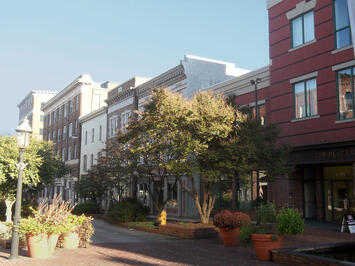
Returning to New York City from a trip to Salisbury, Maryland, it is clear why so many younger Americans are so open to giving up the displeasures of a dense metropolis—high crime, high costs, and constant competition for amenities—for affordable, easy-to-navigate small-town environs like this fantastic city nestled within the Chesapeake’s Eastern Shore. Salisbury is a small city of about 30,000 and growing with a small urban core situated within a larger rural region. It is in close proximity to major urban centers such as Washington, DC, and Virginia Beach, as well. Natural amenities, like the Atlantic coast and the Chesapeake Bay, are close by and the city is bolstered with a vibrant culture, a quality university, and steady job growth.
What was remarkable, however, was the density and variety of third places—community-anchoring spaces where people spend time between home and work and are the critical locations where people exchange ideas, socialize, and build relationships. Salisbury has the usual chain and big box stores and eateries, but it also supports a plethora of local, community-centric spaces such as Rise Up Coffee, a local micro-chain with 12 locations along the Eastern Shore. I visited the East College location and this spot is busy from its 6:00 a.m. opening until its 7:00 p.m. closure. The dozen or so indoor tables and many outdoor tables are regularly full, and while plenty of people grab and go, many linger and talk for considerable amounts of time. Rise Up is far more than just a place for caffeine.
Right next door is a gourmet pizzeria that specializes in craft beer and is open on many nights as late as 11:00 p.m. or even 1:00 a.m. Like the neighboring coffee shop, the pizzeria is so much more than just a place to eat and drink. Attracting students from the nearby university along with families and younger couples, this establishment has busy social spaces for chatting and even regular shuffleboard tournaments. Similarly, Evolution Craft Brewing, a five-minute drive away, has large outdoor and indoor space that goes well beyond the food and drinks; they have created a social atmosphere that is welcoming and is next door to an open-air movie-viewing amphitheater. The brewery’s mission even states that it wants to “involve you and your friends.” This is readily apparent with its fire pits and incredibly lively atmosphere throughout the week.
Perhaps one of the more unanticipated third places that I discovered in Salisbury is Portals—a large shop in a strip mall. It is not only a comic book shop—comic book stores have long traditions of serving as real communal hubs—but a gaming spot for board and card games, along with fantasy and world-building games like Dungeons and Dragons. While this sort of place may be under the radar for most, Portals has space for scores of gamers to play in person and a remarkably vibrant game and meet-up schedule that regularly runs late into the night.
Given my limited time in Salisbury, I am certain that there are more third places that connect residents to the community. But in just a short visit, what is very clear is that for a small city in a fairly rural area, Salisbury is anything but devoid of culture and authentic, real spaces to connect. In fact, many of the third places that I visited are open longer hours and busier than similar shops in New York City today.
None of this is to suggest that the city Salisbury or the Eastern Shore region is some civic panacea or is a place without many real and significant problems and drawbacks akin to its big city counterparts. But Salisbury—like so many other smaller cities, towns, and rural areas that are derided as lifeless or socio-economically dead-end places—has a remarkably rich set of social and cultural institutions. These third places are often unknown or overlooked by urbanists who sing the praises of big urban centers and characterize suburban and rural areas as places devoid of many communal amenities and spaces to connect and create community.
Thus, urban enthusiasts should stop being shocked then when survey data regularly show that the hearts and minds of Gen Z and Millennial Americans have moved away from big cities. Despite big city attempts to attract younger residents, these cohorts repeatedly show little interest in living in big cities, preferring collectively to be outside of older cities where there is more space and more affordability. While sprawling, low-density places may be thought of as centers of social anomie, numerous surveys show that there is little difference in the social lives of urbanites, suburbanites, and their rural counterparts. What I found in Salisbury revealed why: This city along the Eastern Shore has numerous thriving third places. Clearly, younger Americans already know that.
This piece first appeared at AEI.
Samuel J. Abrams is a professor of politics at Sarah Lawrence College and a nonresident senior fellow at the American Enterprise Institute.
Photo: Erica Fischer, via Flickr under CC 2.0 License.












